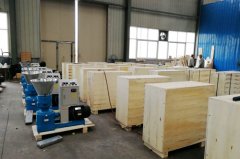Steam Conditioning,Increasing Productivity-Straw Pellet Machine
To make quality straw pellets by straw pellet machine, you should pay more attention to steam conditioning and increasing productivity.
Steam Conditioning: As described in Binding Qualities, materials such as wood and straw contain enough naturally occurring lignin to act as a sufficient binder. Here, we take straw pellet machines for an example.Under the heat and pressure of a straw pellet machine the lignin melts. A pellet is then formed, and once out of the straw pellet machine the lignin cools, producing a strong durable pellet, lignin is also what gives a quality pellet its surface shine. To aid the pellet process and increase productivity large-scale straw pellet machines have steam conditioners, where the material is exposed to dry steam before the material enters the straw pellet machine chamber. The dry steam does not add any
moisture to the material, it is purely used to increase the temperature to aid lignin melting. After steam conditioning the material enters the straw pellet machine chamber, better quality shiny pellets are produced at a higher productivity as the material passes through the die with less resistance due to the materials softened state. Steam conditioning is only used in large-scale straw pellet machines due to the added expense
and safety risks.
Increasing Productivity: Steam conditioning is one way to increase productivity of the straw pellet machine; another way is to use low-density oily materials. Materials such as rape cake or dried distillers grain can aid pellet production by reducing resistance through the straw pellet machine die, while the oil content acts as a secondary binder and produces a strong shiny pellet. Adding up to 20% of the low density oily material to the original raw feedstock can increase productivity by up to 30%.
Pellet Machine Tolerances: Adding oily material to the original feedstock can also increase the tolerances of the straw pellet machine. The oily properties aid the pellet process and can reduce the frequency of blocked dies and poor pellet quality.




